Abstract
Eighty-five trauma patients between the ages of 18 and 55, with American College of Surgeon's (ACOS) trauma scores greater than or equal to 7 were entered into a double-blind, randomized, placebo-controlled study to assess the efficacy of prophylactic fibronectin (Fn) administration on clinical course, sepsis development, and septic mortality. Patients were randomized on admission to receive purified human virus-inactivated Fn or placebo control (human serum albumin, HSA). Fn or HSA was administered on a daily basis if and when the patient was Fn deficient (less than 75% normal). When a Fn deficiency was not evident, the patient received saline. Seventy one patients developed Fn deficiencies during their initial clinical course: 36 received Fn, 35 received HSA. Fourteen patients did not develop a Fn deficiency after trauma and thus received only saline. Analysis of admission data demonstrated no significant differences between the three groups with respect to extent of injury (injury severity score, ACOS trauma score) or physiologic assessments of organ function (serum creatinine, bilirubin, lactic acid). On day 1 after trauma, Fn levels were shown to correlate with other plasma proteins and cellular components (range of r values, 0.24 to 0.75; all p less than 0.05), but not with organ function parameters. Eighteen of 85 patients became septic as judged by clinical criteria. Ten of these patients had received Fn (10 of 36), five had received HSA (5 of 35), and three had received only saline (3 of 14) before the development of sepsis (differences not significant). When septic, nine of 17 patients developed Fn deficiencies. Six patients received Fn while septic, three received albumin, and eight received saline. Seven patients died: 5 of 6 Fn patients, 1 saline, and 1 HSA recipient. Our data suggest that exogenous Fn repletion in states of deficiency does not alter clinical course, the development of sepsis, or septic mortality.
Full text
PDF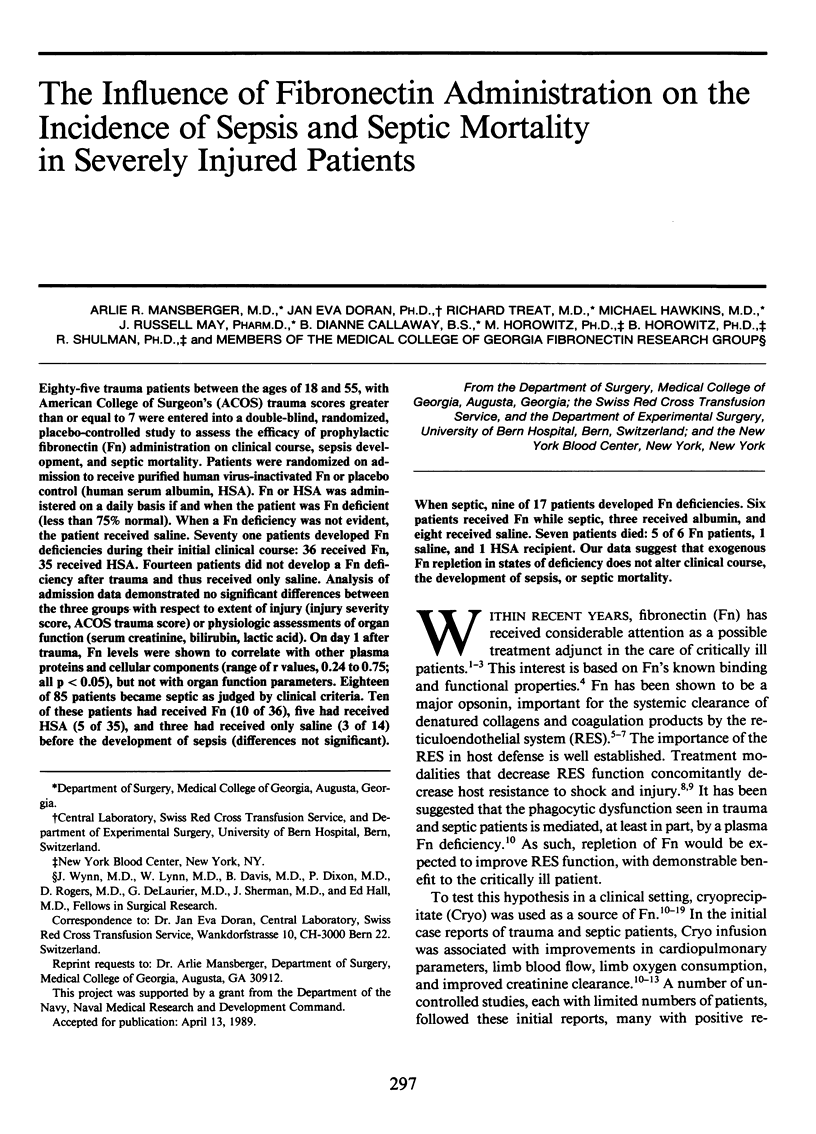
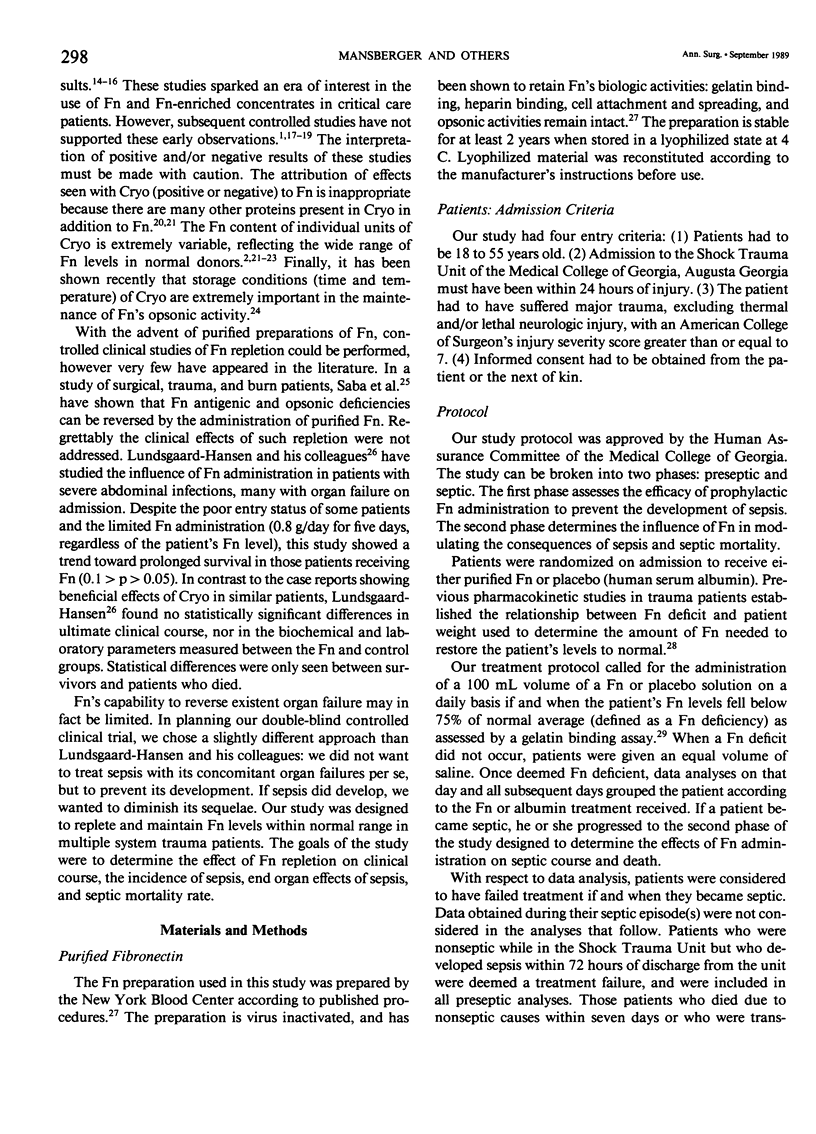
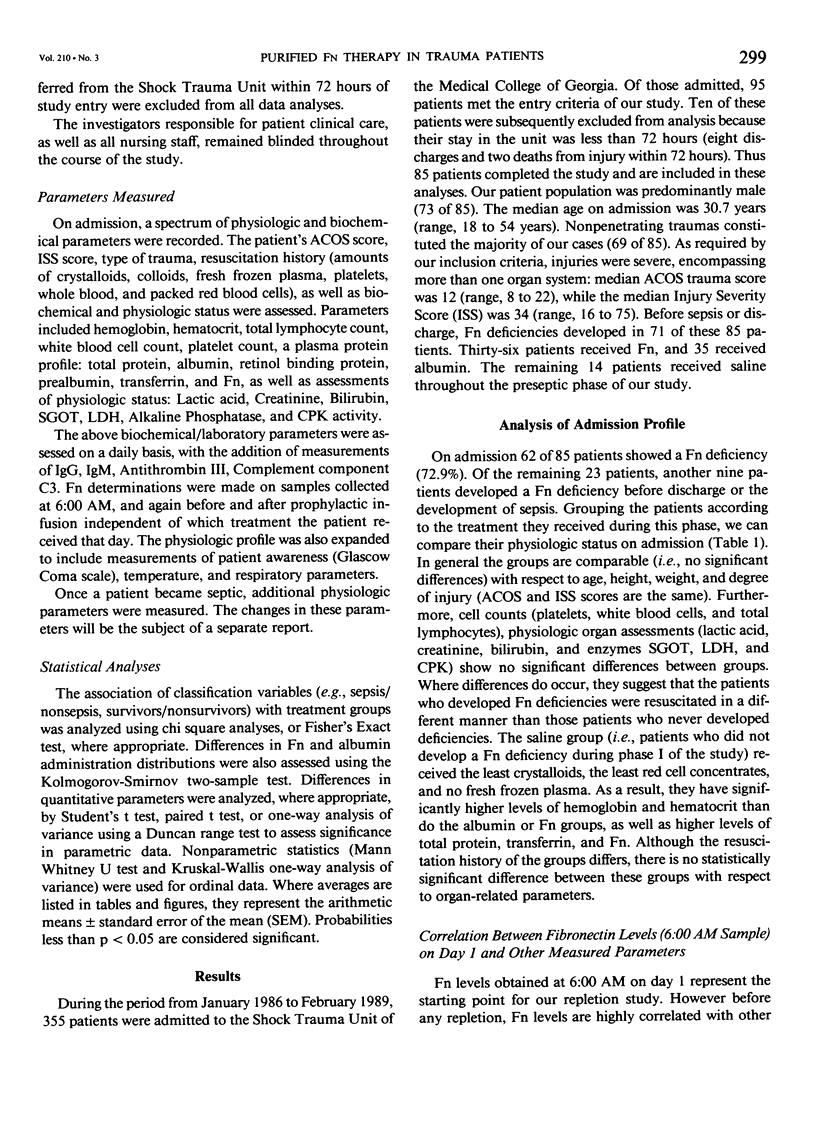

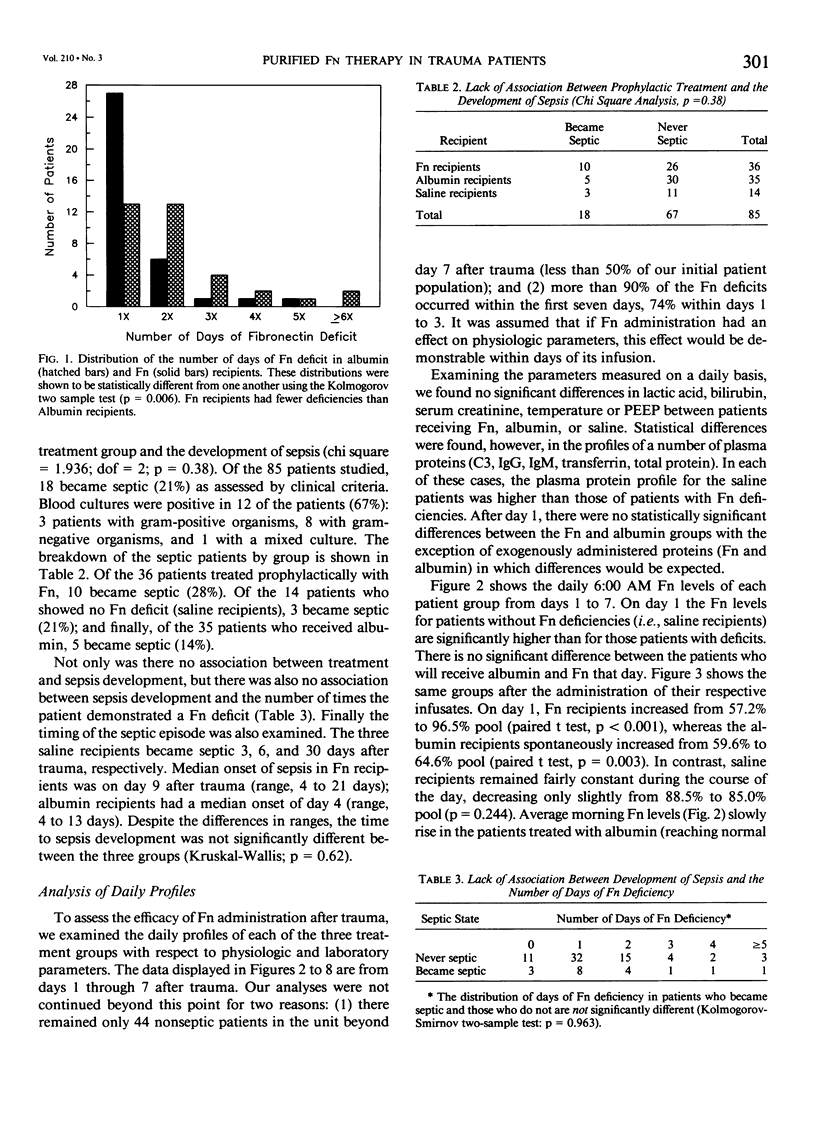
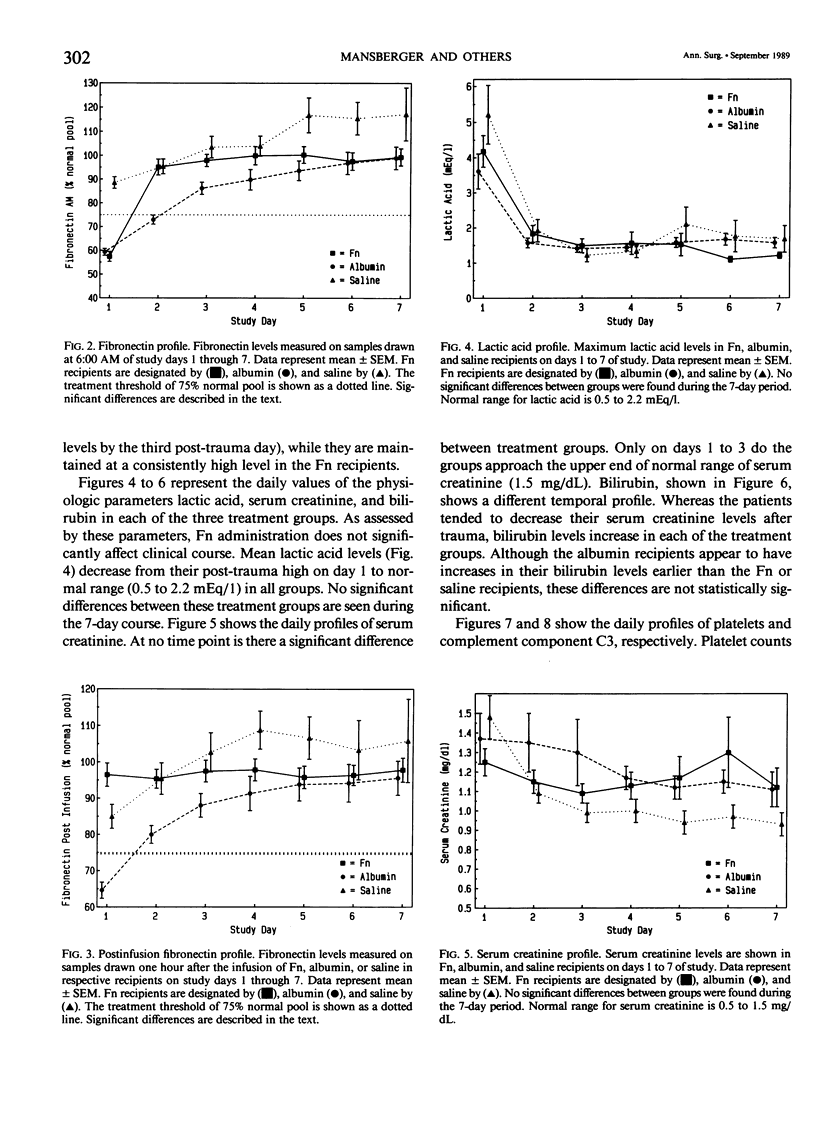
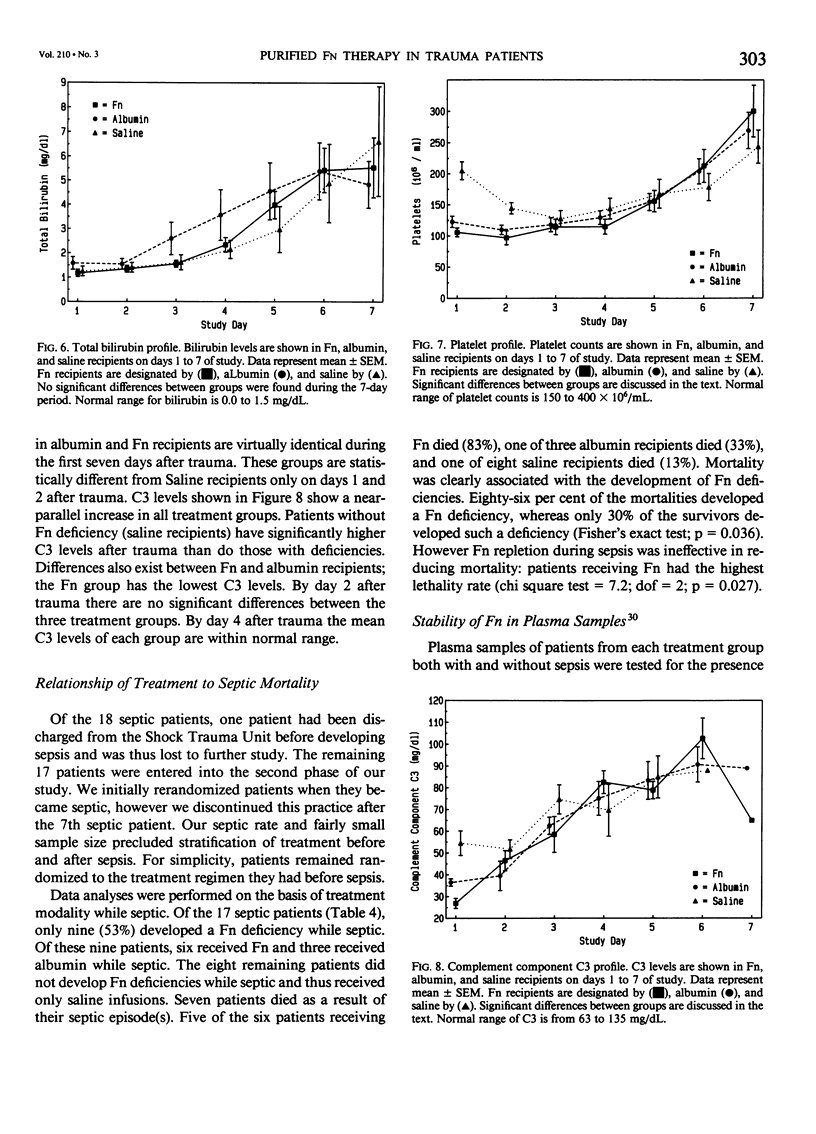
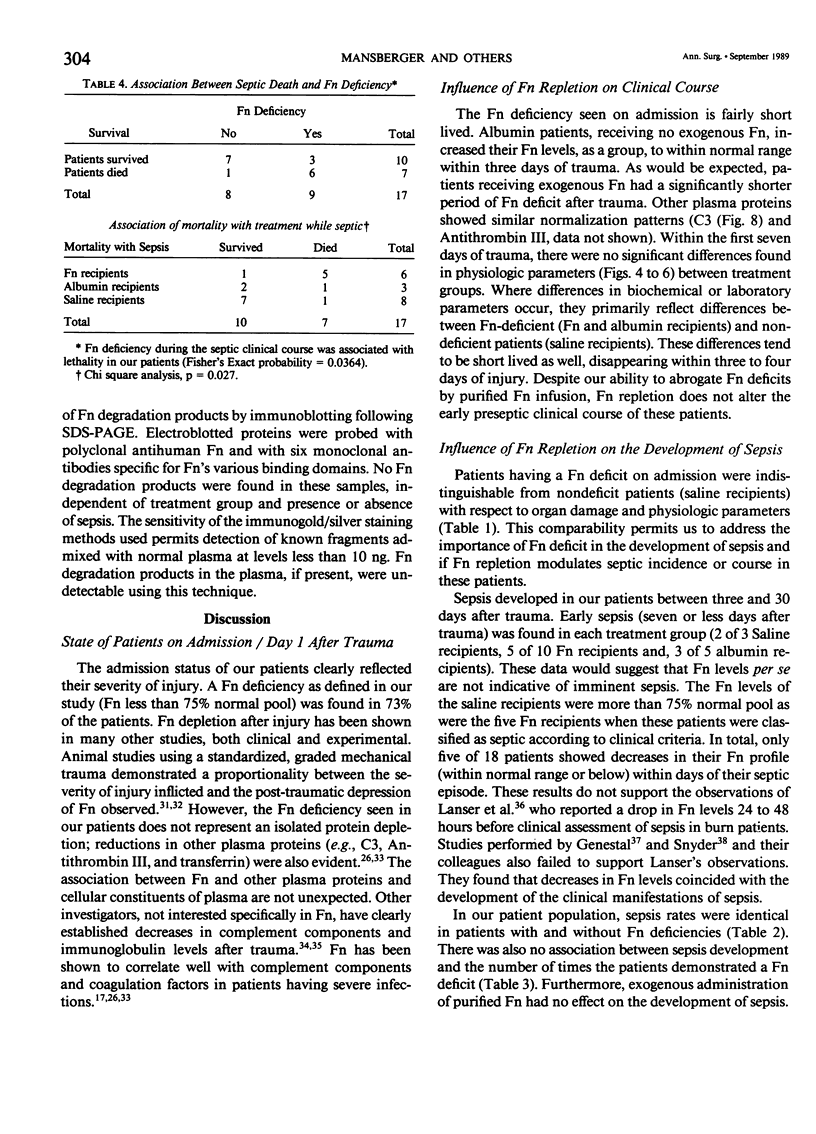
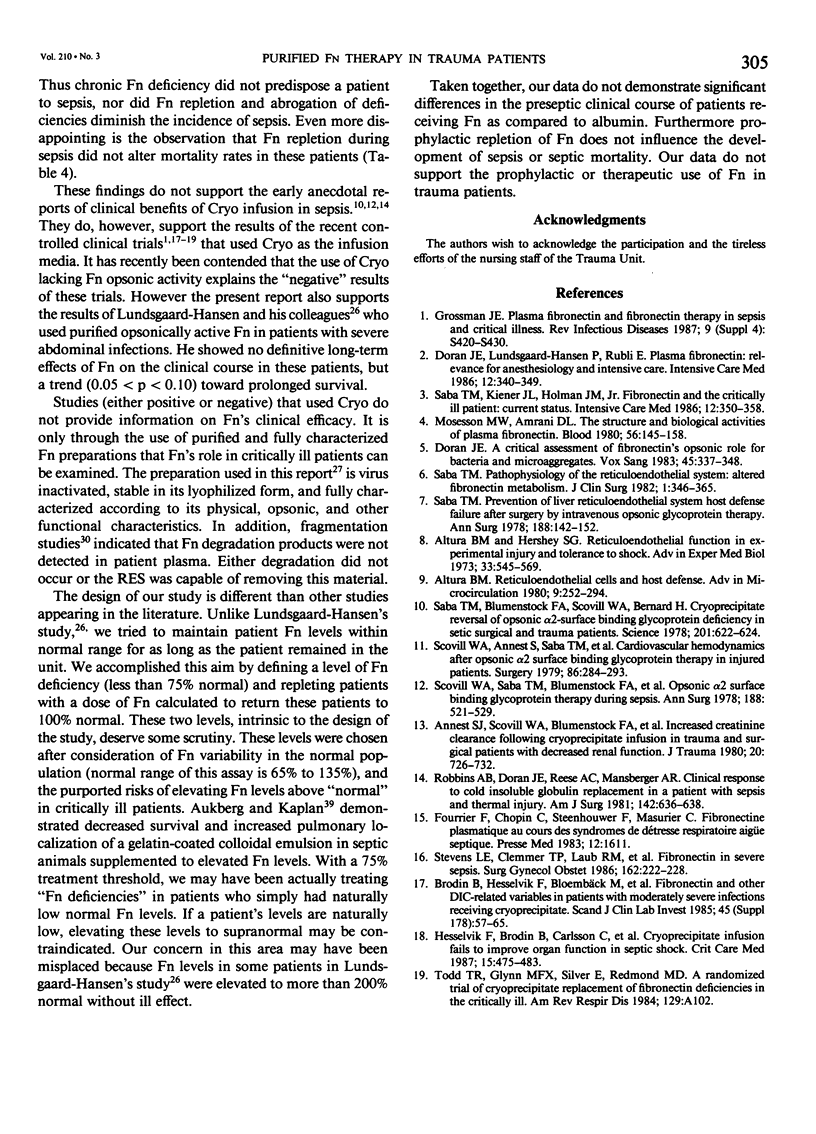
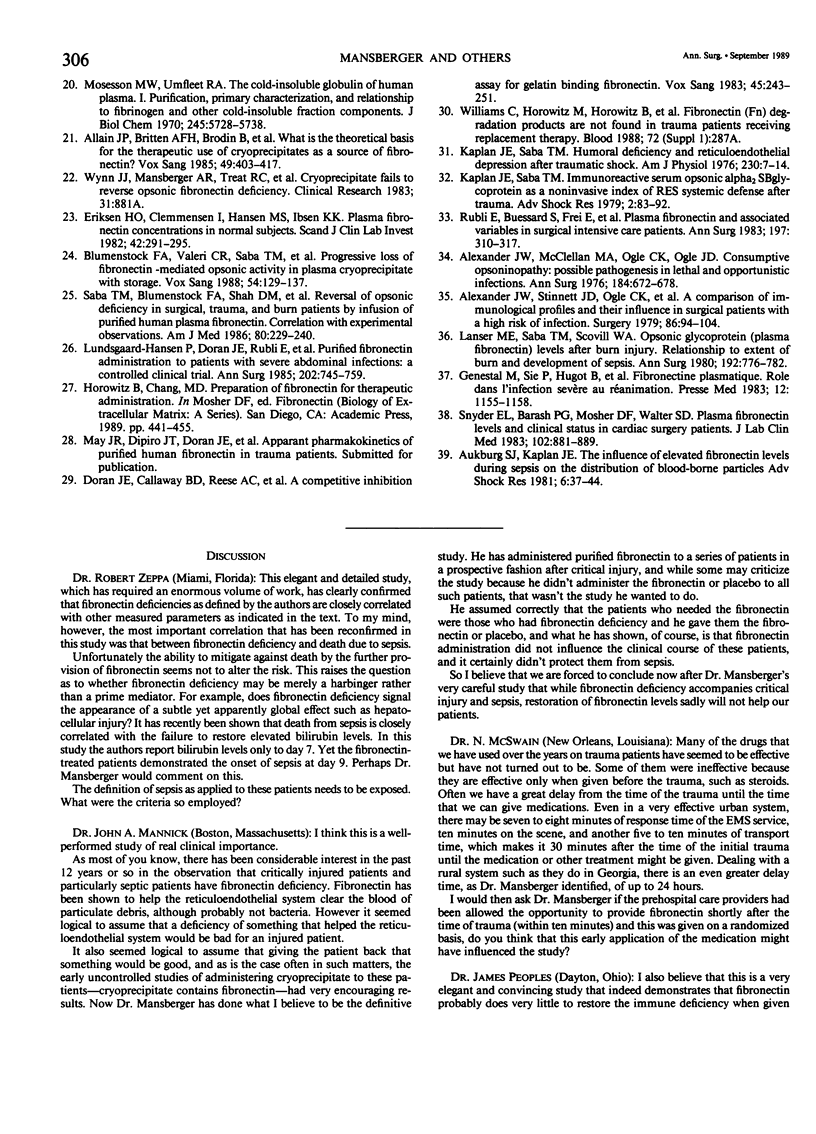
Selected References
These references are in PubMed. This may not be the complete list of references from this article.
- Alexander J. W., McClellan M. A., Ogle C. K., Ogle J. D. Consumptive opsoninopathy: possible pathogenesis in lethal and opportunistic infections. Ann Surg. 1976 Dec;184(6):672–678. doi: 10.1097/00000658-197612000-00002. [DOI] [PMC free article] [PubMed] [Google Scholar]
- Alexander J. W., Stinnett J. D., Ogle C. K., Ogle J. D., Morris M. J. A comparison of immunologic profiles and their influence on bacteremia in surgical patients with a high risk of infection. Surgery. 1979 Jul;86(1):94–104. [PubMed] [Google Scholar]
- Altura B. M., Hershey S. G. Reticuloendothelial function in experimental injury and tolerance to shock. Adv Exp Med Biol. 1972;33(0):545–569. doi: 10.1007/978-1-4684-3228-2_57. [DOI] [PubMed] [Google Scholar]
- Annest S. J., Scovill W. A., Blumenstock F. A., Stratton H. H., Newell J. C., Paloski W. H., Saba T. M., Powers S. R. Increased creatinine clearance following cryoprecipitate infusion in trauma and surgical patients with decreased renal function. J Trauma. 1980 Sep;20(9):726–732. doi: 10.1097/00005373-198009000-00003. [DOI] [PubMed] [Google Scholar]
- Blumenstock F. A., Valeri C. R., Saba T. M., Cho E., Melaragno A., Gray A., Lewis M. Progressive loss of fibronectin-mediated opsonic activity in plasma cryoprecipitate with storage. Role of fibronectin fragmentation. Vox Sang. 1988;54(3):129–137. doi: 10.1111/j.1423-0410.1988.tb03887.x. [DOI] [PubMed] [Google Scholar]
- Brodin B., Hesselvik F., Blombäck M., Cedergren B., Lieden G., Maller R., Strindberg J. Fibronectin and other DIC-related variables in patients with moderately severe infections receiving cryoprecipitate. Scand J Clin Lab Invest Suppl. 1985;178:57–65. [PubMed] [Google Scholar]
- Doran J. E. A critical assessment of fibronectin's opsonic role for bacteria and microaggregates. Vox Sang. 1983;45(5):337–348. doi: 10.1111/j.1423-0410.1983.tb01925.x. [DOI] [PubMed] [Google Scholar]
- Doran J. E., Callaway B. D., Reese A. C., Wynn J. J., Mansberger A. R. A competitive inhibition assay for gelatin binding fibronectin. Vox Sang. 1983;45(3):243–251. doi: 10.1111/j.1423-0410.1983.tb01910.x. [DOI] [PubMed] [Google Scholar]
- Doran J. E., Lundsgaard-Hansen P., Rubli E. Plasma fibronectin: relevance for anesthesiology and intensive care. Intensive Care Med. 1986;12(5):340–349. doi: 10.1007/BF00292924. [DOI] [PubMed] [Google Scholar]
- Eriksen H. O., Clemmensen I., Hansen M. S., Ibsen K. K. Plasma fibronectin concentration in normal subjects. Scand J Clin Lab Invest. 1982 May;42(3):291–295. doi: 10.1080/00365518209168088. [DOI] [PubMed] [Google Scholar]
- Fourrier F., Chopin C., Steenhouwer F., Masurier C. Fibronectine plasmatique au cours des syndromes de détresse respiratoire aiguë septique. Presse Med. 1983 Jun 11;12(25):1611–1611. [PubMed] [Google Scholar]
- Genestal M., Sie P., Hugot B., Cathala B., Boneu B., Lareng L. Fibronectine plasmatique. Rôle dans l'infection sévère en réanimation. Presse Med. 1983 Apr 23;12(18):1155–1158. [PubMed] [Google Scholar]
- Grossman J. E. Plasma fibronectin and fibronectin therapy in sepsis and critical illness. Rev Infect Dis. 1987 Jul-Aug;9 (Suppl 4):S420–S430. doi: 10.1093/clinids/9.supplement_4.s420. [DOI] [PubMed] [Google Scholar]
- Hesselvik F., Brodin B., Carlsson C., Cedergren B., Jorfeldt L., Liedén G. Cryoprecipitate infusion fails to improve organ function in septic shock. Crit Care Med. 1987 May;15(5):475–483. doi: 10.1097/00003246-198705000-00004. [DOI] [PubMed] [Google Scholar]
- Kaplan J. E., Saba T. M. Humoral deficiency and reticuloendothelial depression after traumatic shock. Am J Physiol. 1976 Jan;230(1):7–14. doi: 10.1152/ajplegacy.1976.230.1.7. [DOI] [PubMed] [Google Scholar]
- Kaplan J. E., Saba T. M. Immunoreactive serum opsonic alpha 2 sb glycoprotein as a noninvasive index of RES systemic defense after trauma. Adv Shock Res. 1979;2:83–92. [PubMed] [Google Scholar]
- Lanser M. E., Saba T. M., Scovill W. A. Opsonic glycoprotein (plasma fibronectin) levels after burn injury. Relationship to extent of burn and development of sepsis. Ann Surg. 1980 Dec;192(6):776–782. doi: 10.1097/00000658-198012000-00014. [DOI] [PMC free article] [PubMed] [Google Scholar]
- Lundsgaard-Hansen P., Doran J. E., Rubli E., Papp E., Morgenthaler J. J., Späth P. Purified fibronectin administration to patients with severe abdominal infections. A controlled clinical trial. Ann Surg. 1985 Dec;202(6):745–759. doi: 10.1097/00000658-198512000-00015. [DOI] [PMC free article] [PubMed] [Google Scholar]
- Mosesson M. W., Amrani D. L. The structure and biologic activities of plasma fibronectin. Blood. 1980 Aug;56(2):145–158. [PubMed] [Google Scholar]
- Mosesson M. W., Umfleet R. A. The cold-insoluble globulin of human plasma. I. Purification, primary characterization, and relationship to fibrinogen and other cold-insoluble fraction components. J Biol Chem. 1970 Nov 10;245(21):5728–5736. [PubMed] [Google Scholar]
- Robbins A. B., Doran J. E., Reese A. C., Mansberger A. R., Jr Clinical response to cold insoluble globulin replacement in a patient with sepsis and thermal injury. Am J Surg. 1981 Nov;142(5):636–638. doi: 10.1016/0002-9610(81)90443-8. [DOI] [PubMed] [Google Scholar]
- Rubli E., Büssard S., Frei E., Lundsgaard-Hansen P., Pappova E. Plasma fibronectin and associated variables in surgical intensive care patients. Ann Surg. 1983 Mar;197(3):310–317. doi: 10.1097/00000658-198303000-00011. [DOI] [PMC free article] [PubMed] [Google Scholar]
- Saba T. M., Blumenstock F. A., Scovill W. A., Bernard H. Cryoprecipitate reversal of opsonic alpha2-surface binding glycoprotein deficiency in septic surgical and trauma patients. Science. 1978 Aug 18;201(4356):622–624. doi: 10.1126/science.675246. [DOI] [PubMed] [Google Scholar]
- Saba T. M., Blumenstock F. A., Shah D. M., Landaburu R. H., Hrinda M. E., Deno D. C., Holman J. M., Jr, Cho E., Dayton C., Cardarelli P. M. Reversal of opsonic deficiency in surgical, trauma, and burn patients by infusion of purified human plasma fibronectin. Correlation with experimental observations. Am J Med. 1986 Feb;80(2):229–240. doi: 10.1016/0002-9343(86)90014-8. [DOI] [PubMed] [Google Scholar]
- Saba T. M., Kiener J. L., Holman J. M., Jr Fibronectin and the critically ill patient: current status. Intensive Care Med. 1986;12(5):350–358. doi: 10.1007/BF00292925. [DOI] [PubMed] [Google Scholar]
- Saba T. M. Prevention of liver reticuloendothelial systemic host defense failure after surgery by intravenous opsonic glycoprotein therapy. Ann Surg. 1978 Aug;188(2):142–152. doi: 10.1097/00000658-197808000-00003. [DOI] [PMC free article] [PubMed] [Google Scholar]
- Scovill W. A., Annest S. J., Saba T. M., Blumenstock F. A., Newell J. C., Stratton H. H., Powers S. R. Cardiovascular hemodynamics after opsonic alpha-2-surface binding glycoprotein therapy in injured patients. Surgery. 1979 Aug;86(2):284–293. [PubMed] [Google Scholar]
- Scovill W. A., Saba T. M., Blumenstock F. A., Bernard H., Powers S. R., Jr Opsonic alpha2 surface binding glycoprotein therapy during sepsis. Ann Surg. 1978 Oct;188(4):521–529. doi: 10.1097/00000658-197810000-00009. [DOI] [PMC free article] [PubMed] [Google Scholar]
- Snyder E. L., Barash P. G., Mosher D. F., Walter S. D. Plasma fibronectin level and clinical status in cardiac surgery patients. J Lab Clin Med. 1983 Dec;102(6):881–889. [PubMed] [Google Scholar]
- Stevens L. E., Clemmer T. P., Laub R. M., Miya F., Robbins L. Fibronectin in severe sepsis. Surg Gynecol Obstet. 1986 Mar;162(3):222–228. [PubMed] [Google Scholar]
- What is the theoretical basis for the therapeutic use of cryoprecipitates as a source of fibronectin? Vox Sang. 1985;49(6):403–417. [PubMed] [Google Scholar]


